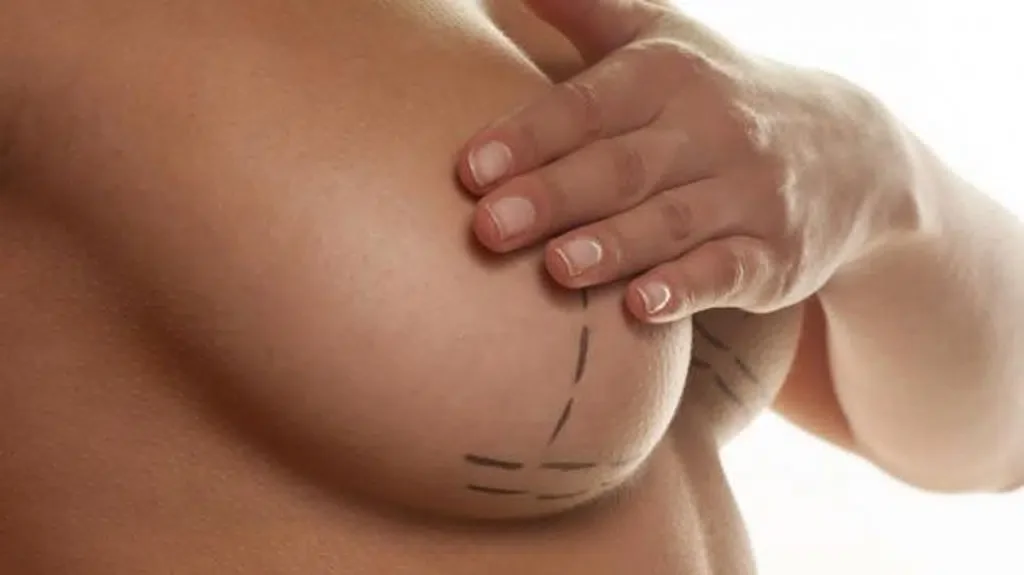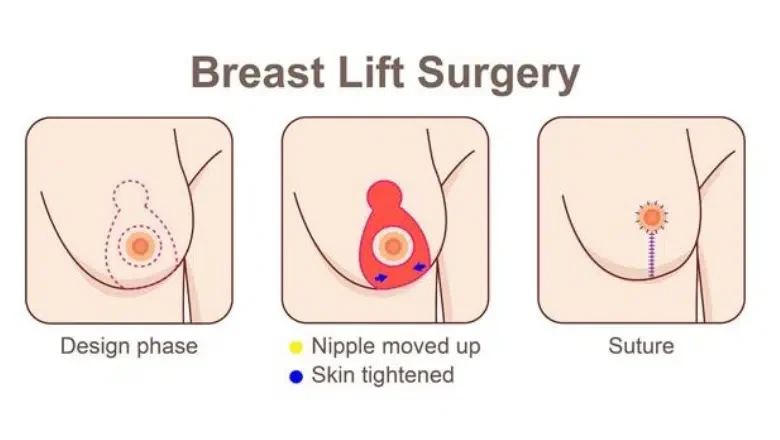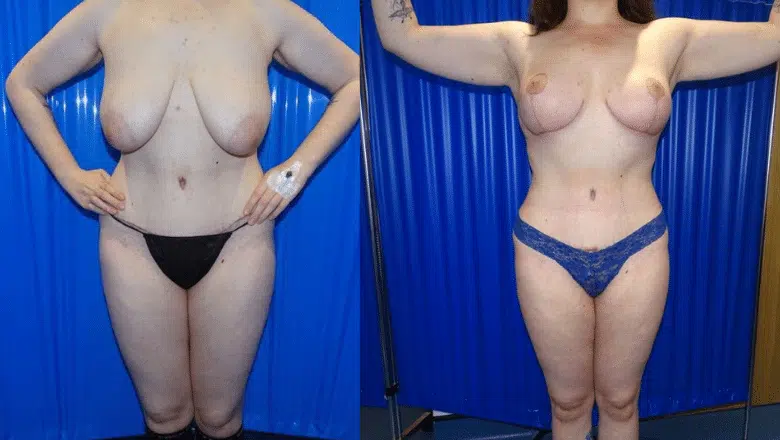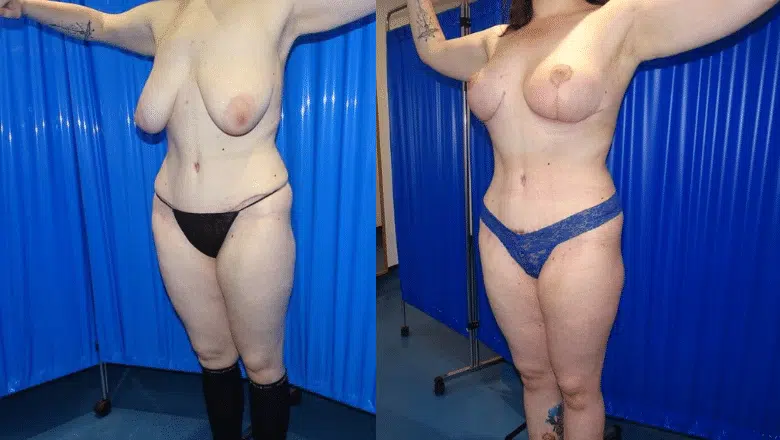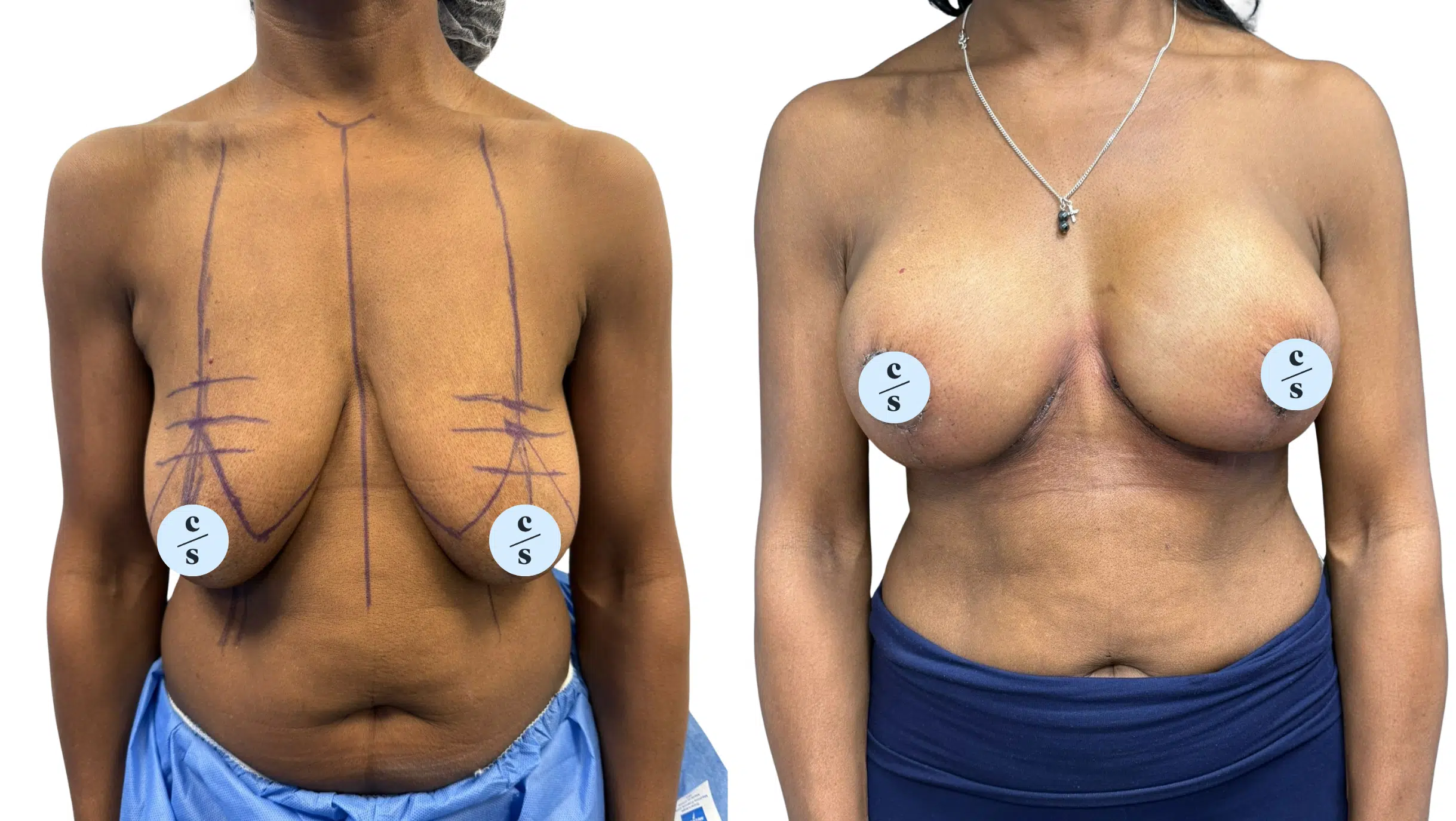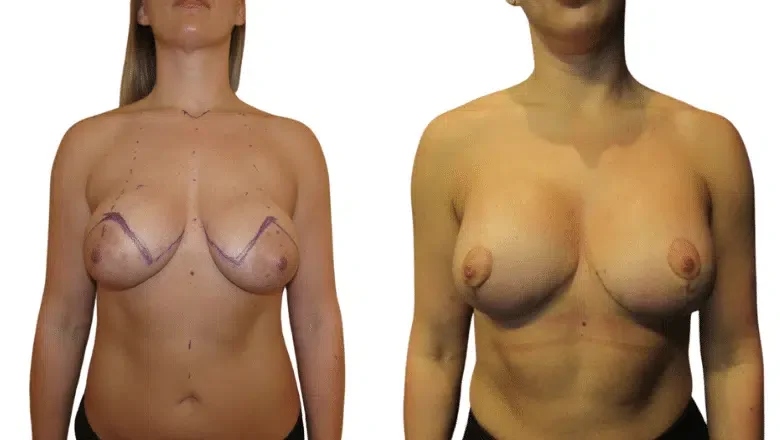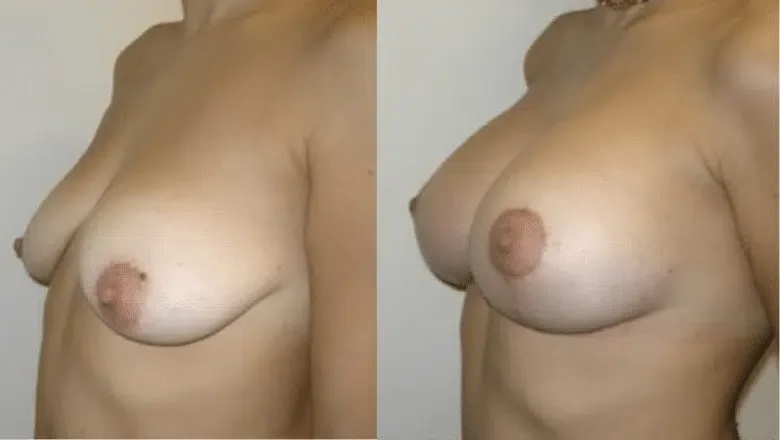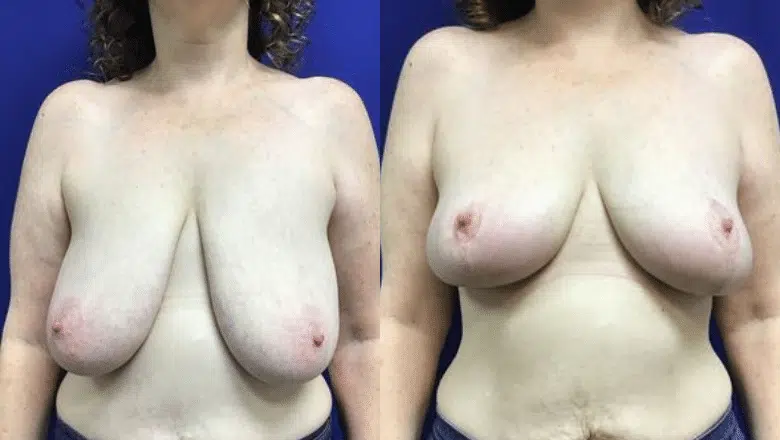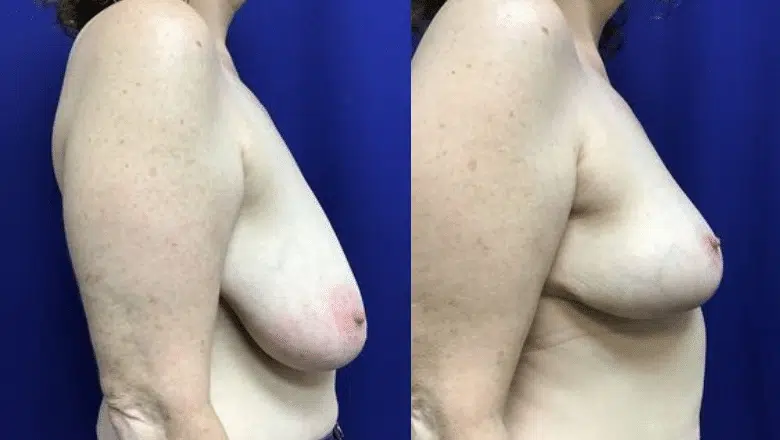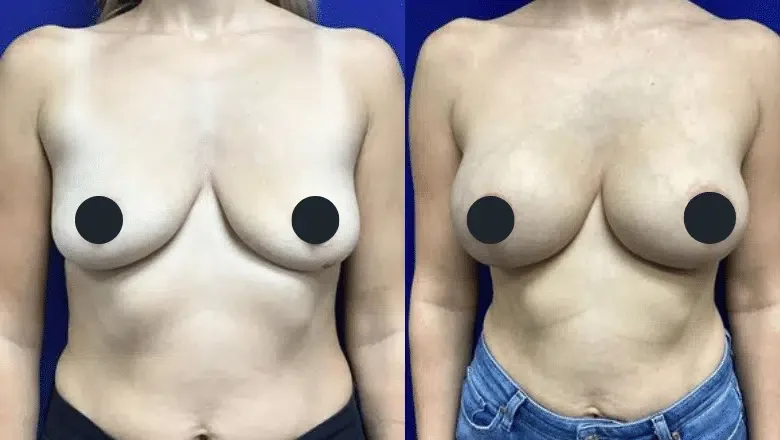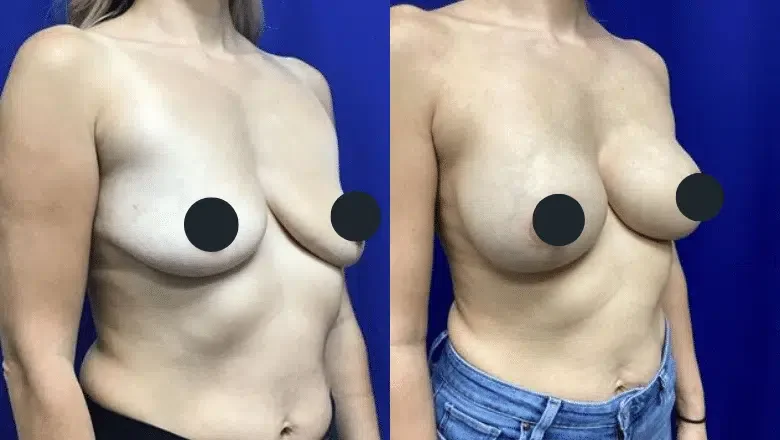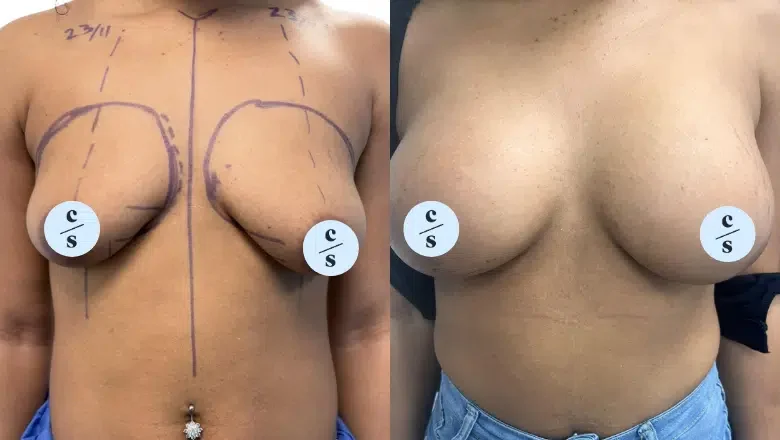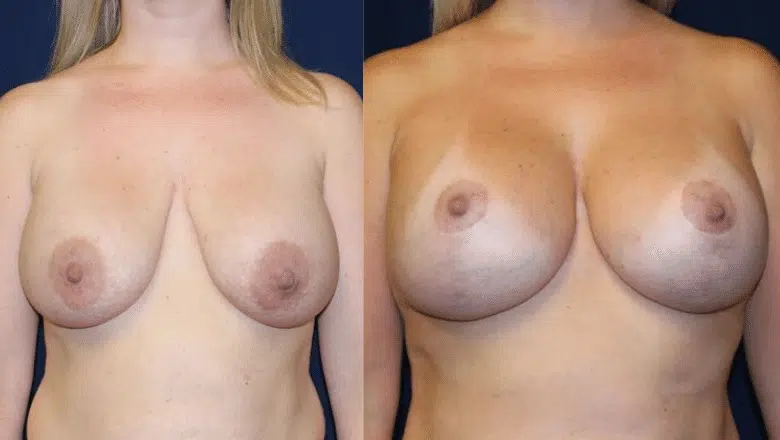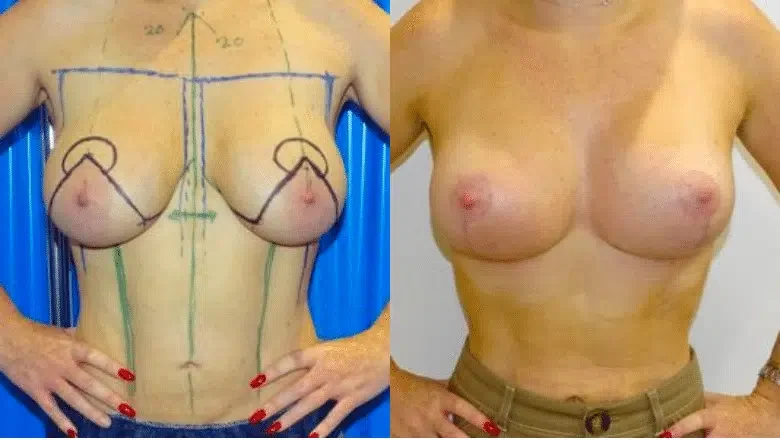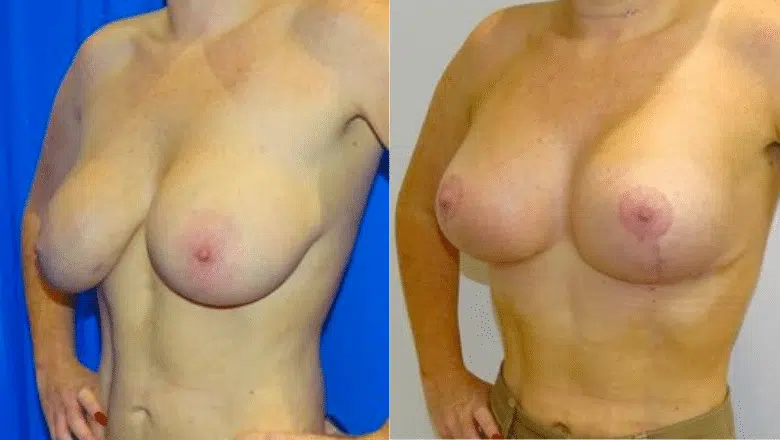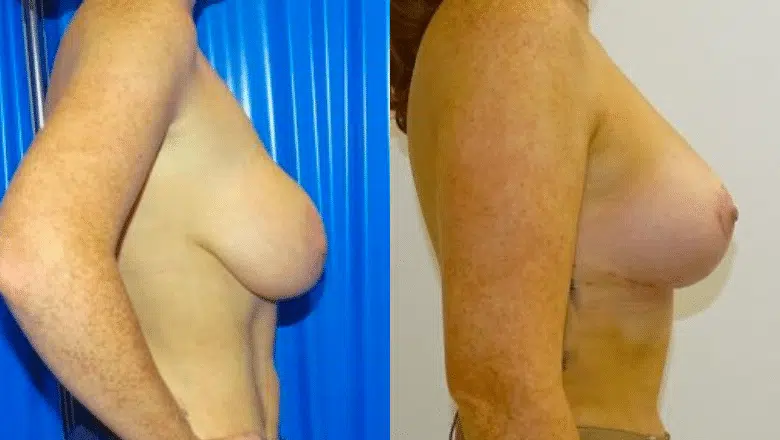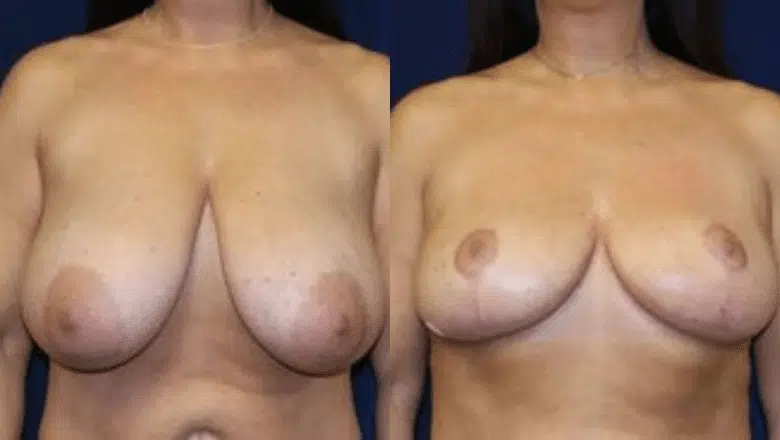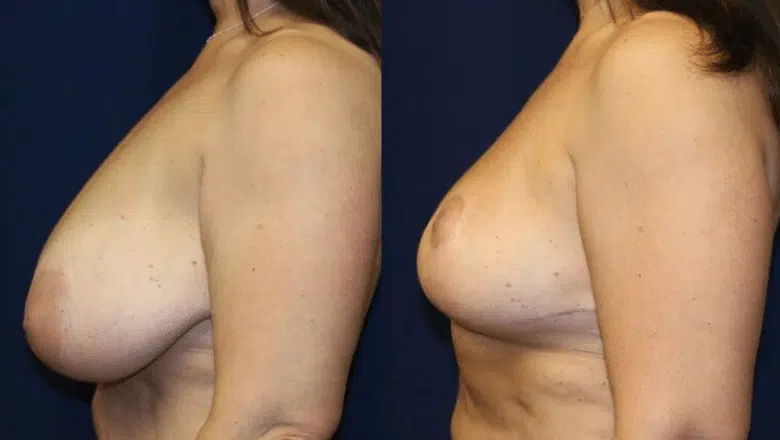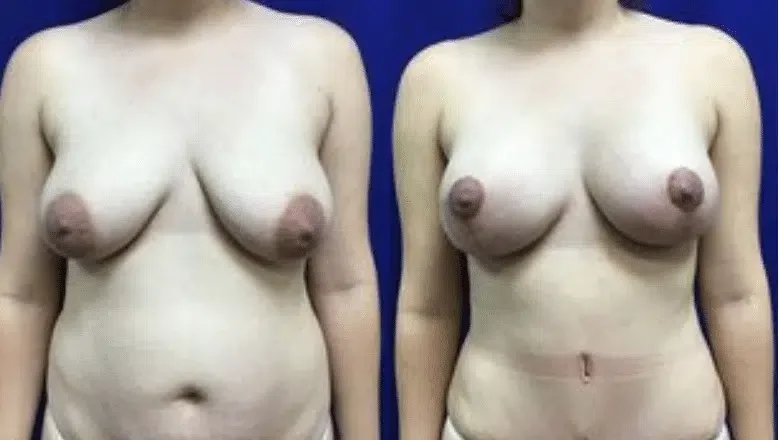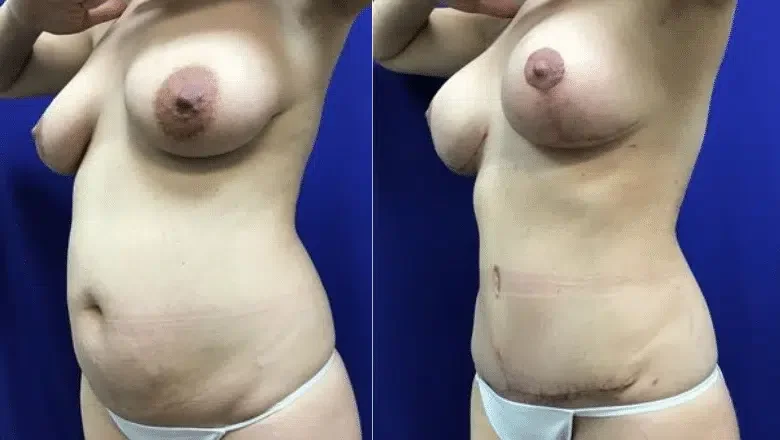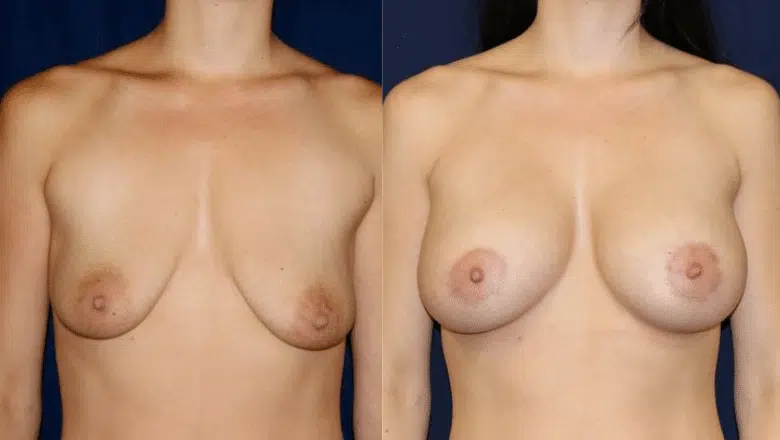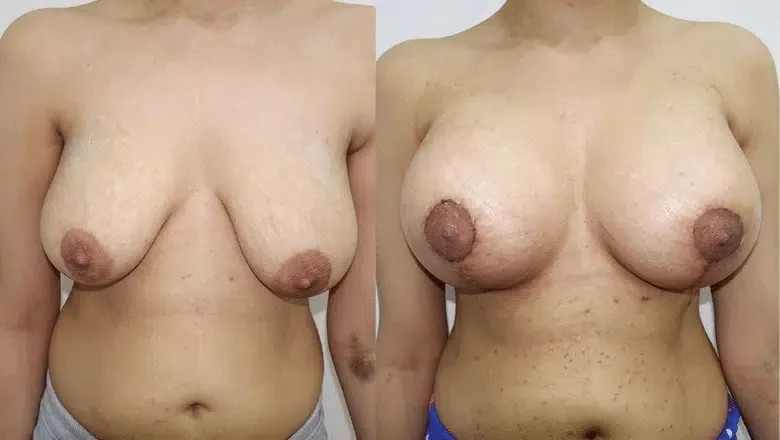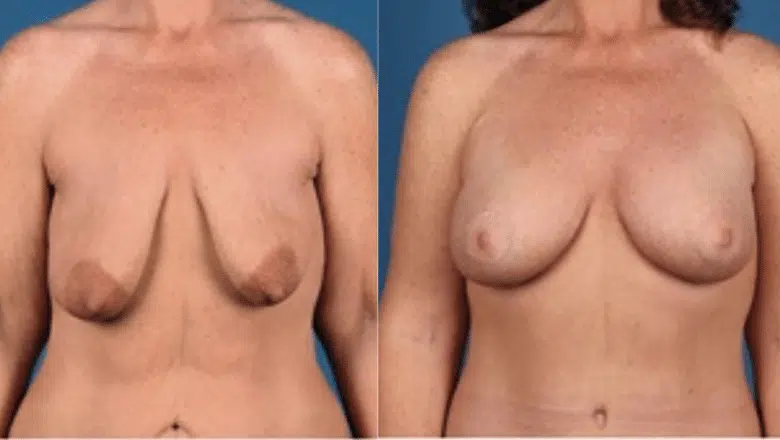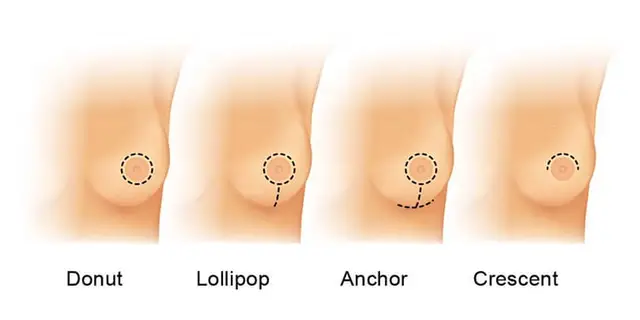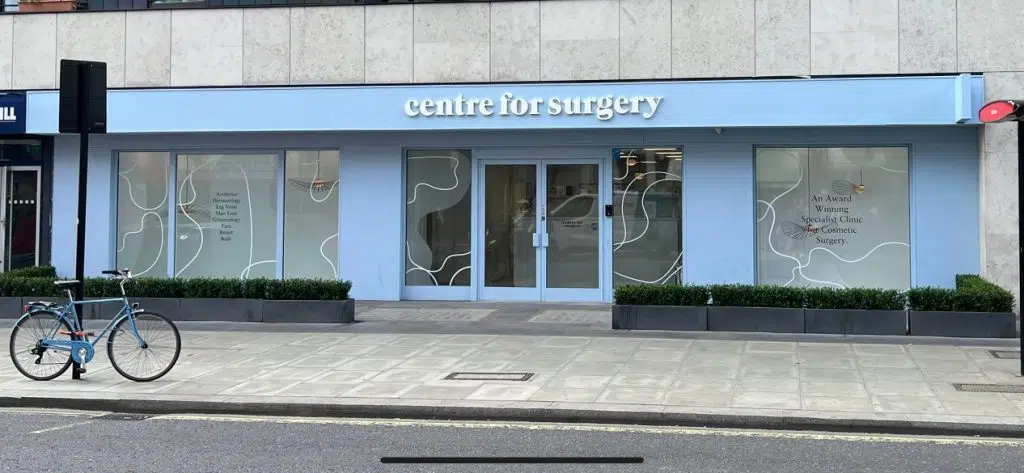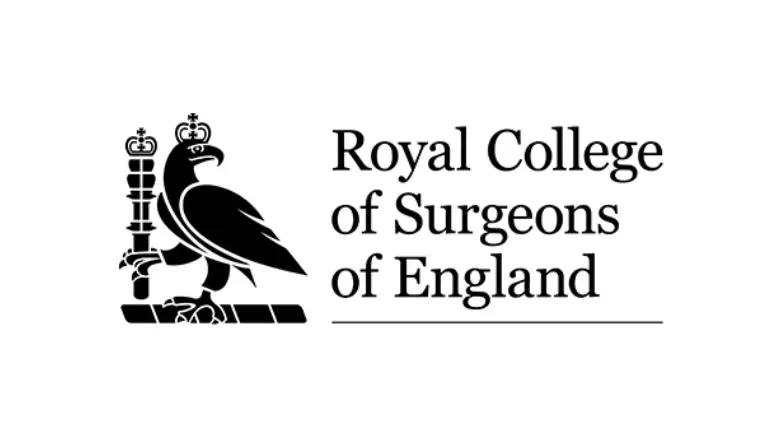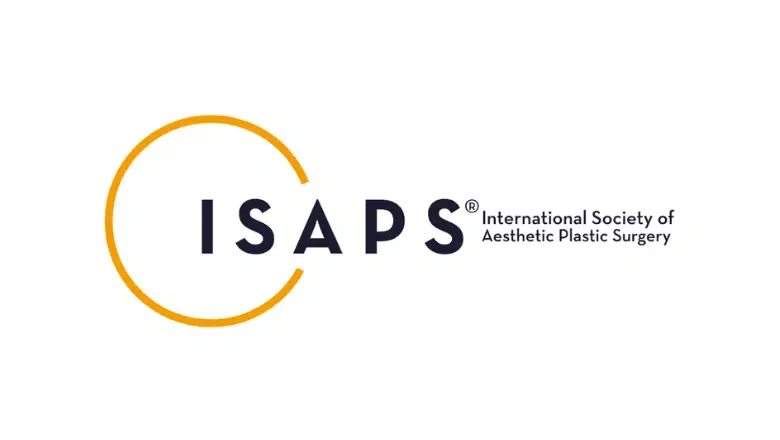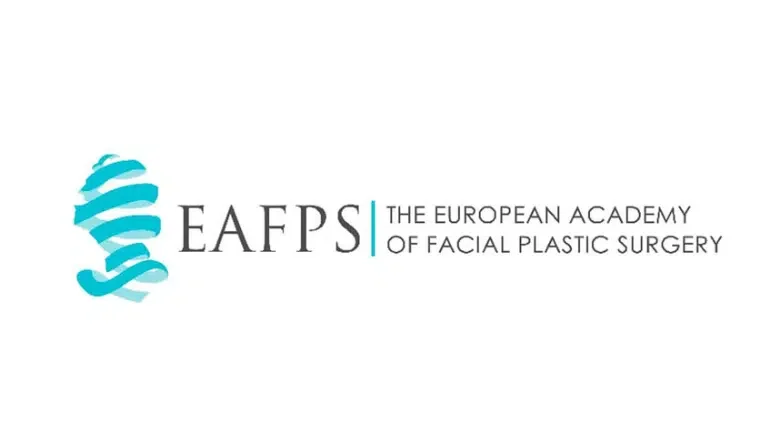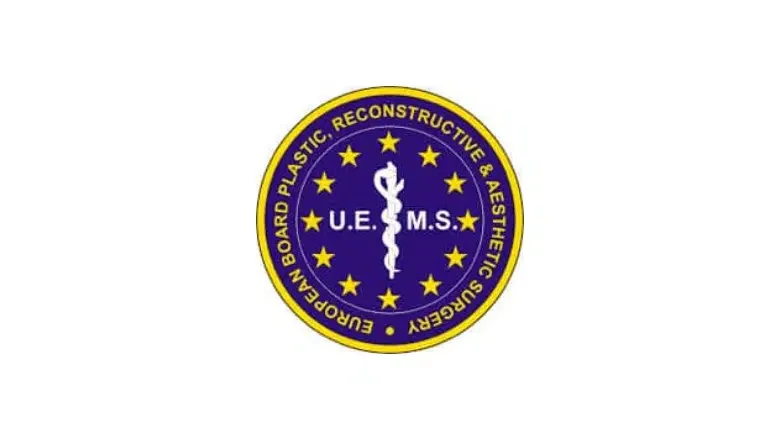Breast Lift in London
Breast lift, also known as ‘breast uplift’, and ‘mastopexy’, is a surgical procedure often considered by women after experiencing significant changes in their breasts after pregnancy, childbirth, and breastfeeding. Over time, the shape and firmness of the breast can undergo substantial changes, particularly an increase in droopiness. Apart from pregnancy, several other factors can affect the shape of the breasts, including changes in weight, genetics, and the natural ageing process, which can significantly impact the shape of the breasts, thus diminishing their youthful appearance. The skin envelope overlying the breasts naturally diminishes in elasticity over the years. This gradual process causes the breasts to droop and is often associated with a pendular appearance of the breasts. The reduction in volume often causes the nipples to drop to a lower position, with a possible increase in areola diameter. Large breasts tend to be more prone to sagging compared to smaller breasts, although any woman may experience these issues. The changes leading to breast atrophy are permanent.
RELATED: Breast Lift FAQs – Q&A about Mastopexy Surgery
Fortunately, there is a robust solution in the form of a breast uplift, which can dramatically restore a more lifted and youthful appearance to the female chest. In most breast lift procedures, the surgeon will perform an enhanced correction to compensate for the breasts falling into their natural position once the swelling from surgery settles down. The net effect of a breast lift is a more ‘perkier’ and prominent breast mound, which has a more natural appearance in harmony with the structure of the chest.
Breast lift surgery, otherwise known as a mastopexy, lifts the breast and involves the removal of excess skin with tightening of the surrounding tissue. While a breast lift does not make the breasts any bigger, it does make the breasts feel firm and can appear more youthful. A breast reduction is similar in the types of incisions used, but in addition to removing skin, the surgeon also removes underlying breast tissue to reduce the size of the breasts. Breast lift surgery is also commonly combined with breast augmentation for women who have both volume loss and drooping of the breasts.
If you want your breasts to look bigger, you may wish to undertake a breast augmentation, uplift, or fat transfer to the breasts.
What is a Breast Lift?
A breast lift, also known as mastopexy, is a surgical procedure that involves reshaping and lifting sagging breasts to give them a firmer, more youthful appearance. The surgery involves removing excess skin and tightening the remaining breast tissue to improve breast contour and projection.
Breast lift surgery can be performed alone or in combination with breast augmentation (implants) or breast reduction, depending on the patient’s desired outcome. It is a standard procedure for women who have experienced significant weight loss, pregnancy, or ageing, which can cause the breasts to lose elasticity and sag.
A breast lift can improve the appearance of the breasts, enhance self-confidence, and provide a more youthful and attractive contour. However, as with any surgical procedure, there are risks and potential complications that should be discussed with a qualified and experienced plastic surgeon.
Breast Lift Before and After Photos
At the Centre for Surgery, we only show photos of breast lift patients who have given full written consent, allowing the use of their images on our website.
Benefits of Breast Lift Surgery
Undergoing breast lift surgery can provide a myriad of benefits that not only enhance the physical appearance of the breasts but also significantly contribute to an individual’s emotional well-being and quality of life. This procedure is meticulously designed to address various concerns related to the aesthetics and functionality of the breasts, offering a holistic improvement to the patient’s overall condition.
One of the primary advantages of a breast lift is its ability to rejuvenate sagging breasts. Over time, factors such as gravity, pregnancy, breastfeeding, and natural ageing can lead to breasts that appear deflated and droopy. A breast lift surgically elevates these breasts, restoring them to a position where they appear fuller and feel firmer to the touch. This key benefit leads to a more youthful and vibrant appearance, with the breasts looking perkier and the upper body gaining a more sculpted and contoured silhouette.
Beyond cosmetic enhancement, a breast lift plays a crucial role in restoring symmetry to the chest area. Breasts are naturally asymmetrical to some degree, but for some individuals, the difference can be pronounced and aesthetically displeasing. Through the strategic reshaping and lifting of the breast tissue, this procedure can significantly improve chest symmetry, thereby enhancing overall body proportions and balance.
The functional benefits of a breast lift extend to the alleviation of medical issues associated with sagging breasts. Conditions such as skin irritation and rashes under the breast folds can be uncomfortable and challenging to manage. By lifting the breasts and reducing excess skin, patients often experience relief from these symptoms, resulting in an improvement in their daily comfort and overall health.
On an emotional and psychological level, the impact of a breast lift can be profound. Many patients report a significant boost in body confidence and self-esteem following their surgery. This renewed sense of self can lead to positive changes in various aspects of life, from personal relationships to professional endeavours.
The aesthetic improvements provided by a breast lift can unlock new possibilities in terms of fashion and clothing choices. Patients often express joy in feeling more comfortable and confident wearing bathing suits, form-fitting tops, and a broader range of clothing styles that they may have previously avoided due to their surgery.
I want more Upper Breast Volume – Do I need a Breast Implant as well?
Breast lift surgery is a highly effective way to improve the shape and firmness of droopy and deflated breasts. However, for women with significant breast ptosis, a large amount of skin may need to be removed during the procedure. As a result, the new breast shape may be smaller in bra cup size.
Breast lift with implants
To enhance the cleavage area and provide additional shape and firmness to the breasts, many women opt to combine breast lift surgery with breast implant placement. Breast implants add volume to the upper part of the breast, where volume loss is often the most significant. Additionally, the intrinsic firmness of breast implants can provide a rounder, fuller breast shape that a breast lift alone may not be able to achieve.
For women with little volume in the cleavage area, a breast lift alone may not be enough to improve or enhance the cleavage. In such cases, adding a breast implant during the mastopexy procedure can provide the desired enhancement and fullness for a rounder, more aesthetically pleasing breast shape.
RELATED: Should I get a Breast lift with implants?
Breast lift surgery alone may make the breasts appear slightly smaller, but it is not a breast reduction. The skin is tightened around the breast gland to create the new shape, but the volume remains the same. To increase cup size or restore lost cleavage and fullness in the upper part of the breast, a breast implant or fat transfer may be recommended in conjunction with a breast lift. This is known as a Breast Lift with Implants or Breast Lift with Fat Grafting procedure.
Our skilled surgeons will take the time to assess your individual needs and goals to determine whether a breast lift alone or a combination of breast lift and implant placement would be most appropriate for you. We are committed to providing personalised care and exceptional results for all of our patients.
Types of Breast Lifts
Several incision techniques can be used for this procedure, each with its own advantages and disadvantages.
RELATED: Types of Breast Lift
The most common techniques used for breast lift surgery include the lollipop lift, anchor lift, doughnut lift or peri-areolar incision, and crescent lift.
Anchor Lift
The anchor lift technique is used for women with severe sagging. The incisions are similar to those used in the lollipop lift, but an additional horizontal incision is made along the breast crease, creating an inverted T or anchor shape. This technique is suitable for individuals seeking a significant combined breast lift.
Lollipop Lift
The lollipop lift technique involves making a circular incision around the areola, followed by an incision down to the breast crease. This technique is ideal for those with moderate sagging or those who do not want to have implants added.
Doughnut Lift
The doughnut lift, also known as the peri-areolar incision technique, involves making a single incision around the areola. This less invasive technique is suitable for patients who want to reposition their nipples to a more aesthetically pleasing area while tightening the skin around the breasts. This procedure can also be combined with breast implants for enhanced results.
Crescent Lift
Finally, the crescent lift is the most minimally invasive procedure used to lift the breasts. This technique involves making a semi-circular incision along the top half of the areola and is suitable for patients who only require minor adjustments to the nipple and areola.
The choice of incision technique will depend on the patient’s individual needs and desired outcomes, as well as the surgeon’s experience and preference. Patients should consult with a qualified and experienced plastic surgeon to discuss all their options and determine the best approach for their unique situation.
The latter two techniques are mini lifts. These techniques will help you achieve the desired results with minimal scarring. Your surgeon will determine the most appropriate method for you. Any prominent scarring can be addressed with several scar management techniques, including laser scar reduction, offered at Centre for Surgery.
When deciding on which technique you should choose, you will need to think about several things, including:
- The size and shape of your breasts
- How much lift will be required
- How much skin elasticity do you have
- Your preferences
The breast lift procedure aims to lift the breasts, increase their firmness, and give them a more youthful appearance.
Am I Suitable for a Breast Lift?
The ideal candidates for breast lift surgery are women experiencing varying degrees of breast sagging, whether it be minor, moderate, or severe. This condition is not exclusive to one demographic and can start affecting women as early as their teenage years, especially those with larger breasts and inadequate skin quality. The size of the breasts plays a critical role in determining the onset of sagging; thus, women with normal to large-sized breasts may find themselves considering this procedure sooner rather than later.
Several factors and criteria must be considered to determine if one is a suitable candidate for breast lift surgery, encompassing both physical and emotional health aspects. Here are the key characteristics of suitable candidates for this transformative procedure:
Experiencing Breast Sagging
Individuals noticing a significant level of sagging and a desire to restore the youthful position and firmness of their breasts are prime candidates. This includes dealing with issues like a lack of volume in the upper pole of the breasts, which can significantly impact the overall aesthetic of the chest.
Physical Health
Candidates should be in good overall health, free from any underlying medical conditions that could complicate the surgery or recovery process. A strong physical foundation ensures that the body can handle the procedure and heal effectively.
Mental and Emotional Well-being
Good mental and emotional health is crucial for anyone considering breast lift surgery. Understanding the procedure, having realistic expectations, and being prepared for the recovery process contribute to a positive surgical experience and satisfaction with the outcomes.
Lifestyle Considerations
Non-smokers or those willing to quit smoking for a designated period before and after the surgery are better positioned for a smooth recovery. Smoking can impede healing and increase the risk of complications.
Medication and Supplements
Candidates should avoid medications or supplements that could interfere with anaesthesia or the surgery’s success. This includes avoiding birth control pills, anti-inflammatory drugs, and certain herbal supplements for at least two weeks before the procedure.
How to Prepare for Breast Lift Surgery
Preparing for a breast lift, also known as mastopexy, can help ensure that you have the best possible outcome from the surgery. Here are some steps you can take to prepare for your breast lift:
Stop smoking
If you smoke, it is essential to quit at least six weeks before your surgery. Smoking can interfere with healing and increase the risk of complications.
Avoid taking certain medications
Certain medications, such as aspirin, ibuprofen, and blood thinners, can increase the risk of bleeding during surgery. Your surgeon will provide you with a list of medications to avoid before the surgery. Arrange for someone to drive you home and stay with you for the first day or two after surgery. After a breast lift, you will likely experience some pain and discomfort and will not be able to drive or care for yourself for a few days.
Prepare your home for recovery
For several weeks after the surgery, you will need to rest and avoid heavy lifting or strenuous activities. Therefore, it’s essential to arrange your home to make it comfortable and easily accessible during your recovery.
Prepare your wardrobe
You will be wearing a surgical bra for several weeks after the surgery, and your clothing options will be limited. Therefore, it’s essential to have comfortable clothing that fits over the bandages and surgical bra.
Follow all preoperative instructions provided by your surgeon
These instructions will include detailed information on preparing for your surgery and will be provided to you before your procedure.
Breast Lift Surgical Techniques
Your breast lift surgery will be performed in our central London Baker Street facility as an outpatient, which means you will be admitted and discharged on the same day.
You will receive general anaesthesia, and the procedure typically takes 3 hours to perform. The surgery may be longer if the breast lift is combined with additional methods. Breast enlargement with uplift takes about 4 hours to perform. A general anaesthetic means you will be comfortably asleep for the procedure.
Breast lift step by step:
STEP 1: For a full breast uplift, the surgeon will make an incision encircling the areola, which then extends vertically downward from the nipple and horizontally across the breast crease. This pattern is known as the ‘anchor type’ incision.
STEP 2: The surgeon then removes skin and fat according to the desired shape.
STEP 3: The surgeon then repositions the nipple upwards into a more natural position that is more forward-facing.
STEP 4: Incision closure. Once the surgeon is satisfied with the overall shape, the incisions will then be closed using dissolvable sutures with special sutures to minimise visible scarring.
After the surgery, you will notice that your breasts appear fuller and more symmetrical. However, the final results will not be visible until the swelling has completely subsided.
Breast lift with implants
If you wish, you can combine breast augmentation and a breast lift and undergo a procedure known as an augmentation mastopexy. This is a good option for women who want to address both the lack of shape in the breasts and the level of sagging. Women with breast asymmetry who only require slight correction or who have been pregnant are considered good candidates for this procedure.
Recovery after mastopexy
First 24 hours
During the first few days following surgery, the pain will be at its most intense. It’s important to talk to your doctor about pain relief and have a course of painkillers prescribed, just in case. You may feel slightly nauseous as the anaesthesia wears off, which is normal. Follow-up appointments with your surgeon may be necessary to remove drains or bandages.
RELATED: Recovery after Breast Lift Surgery – Top Tips
First week
The pain should significantly decrease, although some bruising and swelling may still be present. You can start returning to light activities, such as walking or shopping, but should avoid heavy lifting, bending, and raising your arms above your head. If you work in an office or have a desk-based job, you may be able to return to work.
RELATED: How to Reduce Bruising and Swelling after Breast Lift Surgery
The First Month and Onwards
After a month, you should be able to return to your regular daily routine, except weight lifting and chest-demanding activities. You should continue wearing your surgical bra until your surgeon advises otherwise. You can start wearing an underwire bra around six weeks after surgery. At six months, your breasts should have taken their new shape, and scarring should have diminished completely.
Precautions to Take During Recovery
During the recovery period, there are several precautions that you should take, including:
- Avoiding heavy lifting or strenuous exercise for at least 4-6 weeks
- Refraining from driving for at least a week following surgery
- Avoid sleeping on your stomach
- Maintaining good hygiene around the surgical site
- Following your surgeon’s instructions for pain management
- Wearing your surgical bra as recommended
- Limiting your exposure to sunlight to minimise scarring
- Keeping yourself hydrated
Breast Lift Results
Undergoing a breast lift procedure is a transformative journey that not only reshapes and lifts the breasts but also revitalises one’s self-image and confidence. Initially, post-surgery, patients may experience a sensation of tightness around the breasts, accompanied by their placement being higher on the chest than anticipated. This immediate aftermath is a regular part of the healing process, as the body begins to adapt to the changes and starts its recovery.
As the weeks and months progress, the true essence of the breast lift results starts to unfold. The initial tightness gradually diminishes, and the swelling that contributes to the elevated appearance of the breasts begins to subside. This period of adjustment is crucial, as it allows the breasts to settle into their new shape and position naturally. The transformation during this time is significant, transitioning from the initial post-operative appearance to the outcome that was envisioned before the surgery.
The culmination of this healing process reveals the full benefits of the breast lift procedure. Patients can expect to see and feel breasts that are perkier and more youthful-looking, having achieved the intended shape and position that looks and feels natural. This settling phase is crucial, as it ensures that the breasts align harmoniously with the body’s overall proportions, resulting in a balanced and aesthetically pleasing silhouette.
Achieving the final results of a breast lift surgery is a gradual process that requires patience and proper care. It is essential for patients to closely follow their surgeon’s aftercare instructions, attend follow-up appointments, and maintain a healthy lifestyle to support the healing process. This dedicated approach helps in optimising the outcomes, ensuring that the breasts not only look visually appealing but also feel natural to the touch.
Potential Risks and Complications of Breast Lift Surgery
Breast lift surgery, like any surgical procedure, carries certain risks and potential complications. These risks and complications can vary depending on the patient’s age, general health, and the type of breast lift procedure performed.
Some of the possible risks and complications of breast lift surgery include:
Infection
Infection can occur at the incision site, leading to delayed healing, scarring, and even implant removal.
Bleeding
Excessive bleeding can occur during or after the surgery and may require blood transfusion or re-operation.
Scarring
Any incision will leave a scar, and breast lift surgery is no exception. The location, length, and severity of the scar depend on the technique used and individual factors such as skin type and healing abilities.
Loss of nipple sensation
Nipple sensation loss may occur due to damage to the nerves that supply the nipple.
Asymmetry
There may be a difference in the size, shape, or position of the breasts after surgery.
Poor wound healing
Wound separation or delayed healing can occur, potentially necessitating revision surgery or prolonged healing.
Revision surgery
Sometimes, further surgery may be required to correct unsatisfactory results or address complications.
Breast Lift Cost London - Prices & Fees - How Much Does a Mastopexy London Cost?
Several factors will determine the overall cost of your breast lift procedure, and the final quotation will be provided after your face-to-face consultation with your plastic surgeon.
- Mini uplift or full uplift
- Breast lift alone or combined with breast implants (known as an augmentation-mastopexy)
- Previous breast surgery
Why not call 0207 993 4849 and speak to one of our expert patient coordinators, who may be able to give you a rough costing before your procedure?
Remember that price should never be the determining factor when choosing your provider. We believe that safety and quality of service should be your top priority, instilling in you the confidence that our team will look after you before, during, and after your procedure to the best of their ability.
Breast Lift with Complementary Procedures
While breast lift surgery is effective alone for rejuvenating the appearance of sagging breasts, it can be combined with other procedures to address a broader range of aesthetic concerns. These complementary procedures can significantly enhance the overall outcome, providing more comprehensive improvements in breast shape, size, and contour.
Breast Lift and Reduction
For patients grappling with the challenges of disproportionately large and heavy breasts, a combination of breast reduction and lift offers a compelling solution. Breast reduction surgery focuses on removing excess breast tissue, skin, and fat to alleviate discomfort and achieve a breast size in harmony with the patient’s body frame. When paired with a breast lift, the breasts are reduced in size and raised and reshaped, resulting in a more youthful and uplifted appearance. This dual approach addresses both functional and aesthetic concerns, enhancing physical comfort and self-esteem.
Breast Lift and Augmentation
Breast augmentation, through the insertion of implants beneath the breast tissue, aims to increase the volume and enhance the projection of the breasts. When combined with a breast lift, this procedure caters to women seeking a significant enhancement in both the size and the perkiness of their breasts. The lift component ensures that the augmented breasts are fuller and positioned higher on the chest, creating a more desirable and youthful silhouette. This combination is particularly beneficial for restoring breast volume lost due to ageing, pregnancy, or weight fluctuations.
Breast Lift and Fat Transfer
Fat transfer to the breasts offers an alternative to implants for those seeking augmentation. By harvesting fat from one area of the body and injecting it into the breasts, this procedure provides a natural way to enhance breast size and shape. When combined with a breast lift, fat transfer can add subtle volume while elevating sagging breasts, resulting in a rejuvenated breast profile that feels and looks natural. This approach is ideal for patients seeking a modest increase in breast size, accompanied by a lifting effect.
Hybrid Breast Augmentation
For those seeking a more pronounced increase in breast volume with a natural aesthetic, hybrid breast augmentation alongside a breast lift presents an advanced option. This technique utilises both implants for volume and projection, as well as fat transfer to soften and contour the breast shape. The addition of a breast lift ensures that the breasts are not only larger but also beautifully positioned and shaped. This comprehensive strategy allows for customised enhancements tailored to each patient’s unique desires and anatomy.
Why Choose Centre for Surgery for Breast Lift Surgery?
Centre for Surgery is a renowned cosmetic surgery clinic that offers a wide range of surgical and non-surgical procedures, including breast lift surgery. There are several reasons why you might choose Centre for Surgery for your breast lift procedure:
Highly skilled surgeons
Our team of experienced plastic surgeons are highly skilled and has years of experience in performing breast lift surgery. They use the latest techniques and technologies to ensure the best possible results for each patient.
State-of-the-art facilities
Our clinic is equipped with state-of-the-art facilities and technologies to ensure that patients receive the highest quality of care. We are also registered with the Care Quality Commission (CQC), which means we meet the highest standards of quality and safety.
Personalised care
We believe that every patient is unique and deserves personalised care. We take the time to understand your goals and concerns and work with you to develop a treatment plan that is tailored to your individual needs.
Comprehensive aftercare
We provide comprehensive aftercare to ensure that you have a smooth and comfortable recovery. Our postoperative support team is available to answer any questions or concerns you may have during your recovery.
Competitive pricing
We believe that cosmetic surgery should be accessible to everyone, which is why we offer competitive pricing for our breast lift surgery procedures.
Excellent patient satisfaction
We have a high level of patient satisfaction, with many of our patients recommending us to friends and family. We take pride in our reputation for delivering exceptional results and high-quality care.
What is included in my breast lift treatment package?
- As many preoperative consultations with your surgeon as you like to make sure the mastopexy procedure is right for you
- Treatment at a specialist day surgery facility recently rated ‘Good’ by the CQC
- Enhanced same-day discharge with the added benefits of recovering in your own home
- 24/7 clinical support from your surgeon for the first 48 hours and our expert postoperative support team
- Your very own dedicated patient coordinator
- In-depth preoperative medical assessment to make sure you are fully fit for your breast uplift procedure
- Exceptionally high standards of postoperative care are described as ‘outstanding’ by the CQC with regular telephone and face-to-face checks.
RealSelf Top Doctors for Breast Lift Surgery
RealSelf’s Top Doctor status is awarded to fewer than 10% of the RealSelf doctor community. This status is earned by consistently achieving high patient satisfaction (as rated in RealSelf reviews), receiving excellent feedback on expert answers to patient questions, and investing significant time in Q&A and other doctor-related activities. RealSelf’s top doctors are rated among the best breast surgeons in the UK.
FAQs
-
What is Breast Ptosis?Breast ptosis, also known as sagging breasts or drooping breasts, is a common condition in which the breasts lose their shape and firmness over time. This can occur as a result of factors such as ageing, pregnancy, breastfeeding, weight loss or gain, and genetics.
-
How do I get firmer breasts?Breast lift or mastopexy is ideal for restoring firm breasts and is often performed with breast augmentation surgery. Your surgeon will advise you on the most appropriate treatment option for attaining firmer breasts.
-
What are the different grades of breast ptosis?There are four grades of breast ptosis, or sagging, as defined by the Regnault Classification:
Grade 1: Mild ptosis, where the nipple is at or above the inframammary fold (the crease beneath the breast), and the breast maintains a good shape.
Grade 2: Moderate ptosis, where the nipple is below the inframammary fold but still above the lower pole of the breast. The breast may appear less full and shapely.
Grade 3: Severe ptosis, where the nipple is at or below the inframammary fold, and the breast appears flattened and elongated.
Grade 4: Very severe ptosis, where the nipple is at or below the level of the inframammary fold, and the breast appears pendulous and empty with a flattened lower pole.
In some cases, ptosis may be accompanied by a loss of breast volume or asymmetry in the size and shape of the breasts.
Breast ptosis can have a significant impact on a woman's self-esteem and can also make it difficult to find clothing that fits well. For women who are self-conscious about the appearance of their sagging breasts, breast lift surgery, also known as Mastopexy, may be an option.
The procedure involves removing excess skin and repositioning the nipple and areola to a higher position on the breast. In some cases, the surgeon may also use breast implants to restore lost volume or reshape the breast tissue. -
What is a breast lift or mastopexy?Breast lift is also known as a 'mastopexy' or 'breast uplift' is a cosmetic surgery procedure that is designed to lift and reshape sagging breast tissue and the nipple position. By lifting the breasts, a more youthful look is achieved.
Breast uplift surgery can be combined with breast augmentation using either implants or fat transfer (lipofilling) to restore volume as well as improve shape with a breast lift. -
How Do I Decide Between a Breast Lift with or without Implants?Choosing between a breast lift with or without implants depends largely on your desired breast volume. If you're happy with your current breast size and are looking solely to address sagging, a breast lift without implants may suffice. However, if you desire larger breasts or increased fullness, particularly in the upper part of your breasts, combining a breast lift with implants could be the right choice. It's essential to discuss your goals and expectations with your surgeon during your consultation at our Baker Street clinic to determine the best approach for your needs.
-
How old should I be to qualify for breast lift surgery?Patients should be at least 18 years old before considering having any form of aesthetic breast surgery, including breast lift. It is generally accepted that the breasts will still be undergoing growth and development.
If a breast lift is carried out during this growth phase, then ongoing growth and development as part of the growth spurt may result in a requirement for a further breast lift further down the line. A breast lift before the age of 18 may also cause psychological issues as patients may not be adequately prepared for a surgical procedure which will affect the appearance of the breasts.
Some surgeons believe that early intervention in the form of a breast lift may be indicated when there is a clear structural abnormality of the breast. This could be in the form of unequal sizes, tuberous deformity, and underdeveloped breasts. These can all cause significant psychological harm and may be exacerbated by bullying at school. The most common breast abnormalities are tuberous or tubular breasts. The best strategy in these cases is to adopt a multidisciplinary approach involving the patient's GP and a specialist psychologist to assist in the clinical decision-making process alongside the surgeon. -
What Are the Benefits of Undergoing a Breast Lift Mastopexy?A breast lift mastopexy offers several potential benefits, which should be considered alongside any risks. The primary goal of this surgery is to reshape and elevate the breasts, providing a more youthful and uplifted appearance. This procedure is especially beneficial for those looking to enhance the position and contour of their breasts.
-
Am I the ideal candidate for a breast lift?Ideal candidates for a breast lift include:
- those with droopy and sagging breasts who would prefer more uplifted breasts with a firmer consistency
- patients with good physical health without significant medical conditions such as hypertension or diabetes. Diabetes is known to interfere with wound healing.
- patients with good mental health who understand the risks and complications and have realistic expectations of what breast lift surgery can achieve
- patients who can follow all of the pre-op and post-op instructions to ensure proper healing
- patients who are not smokers
The procedure is mostly preferred by women who have lost the volume and shape of their breasts after pregnancy, weight loss, or ageing. -
What should I do before breast lift mastopexy surgery?Your surgeon will give you a list of instructions to follow prior to your surgery, such as stopping smoking, maintaining a healthy weight, and being in good general and mental health.
-
What are the different types of breast lift?The actual breast lift technique used depends on the patient. Several factors will determine the surgical method used, including the patient's age, the volume of the breasts, the amount of breast tissue that may need to be surgically removed, and the particular aesthetic result that the patient would like to achieve.
There are four recognised techniques for breast lift surgery:
Crescent lift - this is the least invasive type of breast lift and involves the removal of a wedge of tissue at the superior aspect of the nipple, which resembles a crescent. The degree of lift is modest and often more than 1.5 cm at most. The procedure is only suitable for women with mild degrees of breast ptosis.
Doughnut lift - This breast lift is also known as a Benelli procedure or circumareolar mastopexy. This procedure is ideal for the treatment of asymmetry affecting the nipple-areola complex and also for minor degrees of breast uplift. The incision is made around the entire circumference of the areola, and excess skin is removed, followed by the placement of a permanent suture around the areola to induce tightening. A doughnut lift is less invasive than a vertical or inverted T breast lift. Women who would like the size of their areola reduced can also have areola reduction at the same time as performing a doughnut lift.
Lollipop Lift – This is also known as a vertical scar breast lift. The incision is made around the areola and extends vertically down from the six o clock position to the inferior breast fold. For women with drooping breasts, this is an effective technique to lift the breasts. Sometimes, the surgeon may combine a small amount of liposuction to contour the breasts.
Anchor lift - This technique is used for the most severe degrees of breast sagging. The incision is identical to the lollipop lift and with the addition of a horizontal incision along the inferior breast crease for removal of excess skin. The inverted T breast lift is ideal for women with a long distance measured preoperatively from the IMF to the nipple. Women who have undergone massive weight loss often require an anchor lift to address the large quantity of redundant skin. -
Can breast lift surgery be performed without implants?Breast lifts are commonly performed alone without the need for breast implants.
A breast lift alone will achieve a more youthful breast shape and contour through the elevation of the nipple and areola and the removal of redundant skin. The breast uplift procedure raises the height of the nipples and through the repositioning of breast tissue will result in a more natural appearance to their original condition when younger or pre-pregnancy. Mastopexy surgery can optimise both shape and restore symmetry. Sagging breasts can be surgically corrected and this can result in an enormous improvement in self-esteem.
Breast lift surgery is commonly performed because women desire to return to their formerly youthful state and to address both the ageing process, pregnancy, and the effects of gravity with time. Many women may notice a very small reduction in breast size but this is barely noticeable in most patients as only minimal amounts of actual breast tissue are removed. It is mainly skin that is removed.
Fat transfer to the breast, also known as lipo filling or fat grafting can also result in an improvement in breast sagging in a similar manner to the use of breast implants. Fat transfer has the major advantage of being able to shape the breast through the meticulous placement of the fat. For women who are unhappy with their upper pole fullness, fat grafting to the breast can help to fill the deflated upper pole of the breasts which can also result in a more defined cleavage. -
How is breast lift surgery possible as a day case?At Centre for Surgery, we are renowned for our use of TV general anaesthesia which is recognised to be a gentler form of anaesthesia when compared with traditional anaesthesia delivered in hospitals. With modern short-acting drugs and state of the art medicine delivery systems, our anaesthetists are able to keep patience comfortably asleep throughout the duration of their procedure and with a very short and comfortable recovery period without the risk of dizziness, drowsiness or grogginess. This means that patients recover very quickly and are ready for discharge within 2 to 3 hours of the procedure to recover in the comfort of their own homes. Published medical studies consistently demonstrate that patients who have their surgical procedure as a day case have a better outcome compared with those who have traditional inpatient surgery in hospitals.
-
How is breast lift surgery performed?At Centre for Surgery, breast lift or mastopexy surgery is carried out under TIVA general anaesthesia as a day case which means you will be admitted and discharged on the same day. The recovery after TIVA is very quick compared with traditional general anaesthesia with a lower risk of nausea and sickness. Pain is usually very minimal after breast lift surgery and your doctor will prescribe painkillers for you to take regularly at home.
There are a number of recognised techniques for breast lift surgery. The main principle in all techniques is surgical repositioning of breast tissue upwards, nipple-areola repositioning and removal of redundant excess skin.
Breast lift surgery involves incisions placed around the areola which is the darker area around the nipple. For small lifts, this may be enough but for larger breast lifts, more skin will need to be surgically excised and this will result in a scar running from the areola to the inframammary fold beneath the breast. For severe breast sagging, a horizontal breast incision also needs to be made in the breast fold which results in an 'inverted T' appearance. The horizontal breast incision is usually well concealed beneath the breast. Breast lift scars are initially raised and red in colour but will flatten and become pale in colour with time. The type of breast lift technique employed by your surgeon depends on a number of factors including the size and shape of the breasts, skin quality, areola size and the degree of breast lifting required. Before the procedure, the surgeon will carefully mark the breasts with a marker pen whilst you are standing to accurately map the proposed position of the nipple and areola on the uplifted breasts. -
What type of anaesthetic is used for breast lift surgery?At Centre for Surgery, our anaesthetists are experts in the delivery of Total Intravenous Anaesthesia or TIVA for short. TIVA is the most advanced and modern form of general anaesthesia available in the UK. The medicines used in TIVA have both a fast onset and rapid offset which means there is a much lower risk of the residual hangover feeling that many patients experience after a traditional general anaesthetic using volatile gases. The depth of anaesthesia is very precisely controlled using state-of-the-art brain monitoring technology. This means that the right amount of anaesthetic can be given - not too much and not too little. Patients often report very little in way of dizziness or drowsiness, which facilitates a much smoother postoperative recovery. TIVA is ideal for day surgery and is the default anaesthetic used for all our surgical procedures which require a general anaesthetic.
-
How long does a breast lift procedure take?The breast lift procedure takes 2-3 hours on average depending on the type of breast lift required.
-
What is the recovery period like after breast lift?Expect mild post-operative pain for the first three days, but this can be reduced with pain medications, and normal activities can be resumed after the first week following your surgery. However, extensive activities should be avoided for 3-4 weeks.
-
Is breast volume or cup size affecting by breast lift surgery?With breast lift surgery, the volume of the breast does not change appreciably as it is mainly the skin envelope that is removed along with rearrangement of the internal breast tissue and not removing the internal breast tissue as with a breast reduction. A mastopexy without breast implants does not significantly change the size of the breasts. The outcome following breast uplift surgery is a more youthful and perkier breast with an improvement in breast symmetry.
Breast lift combined with implants will result in an increase in cup size due to the presence of the implant. Depending on the size of the implant chosen, a significant increase in breast size is possible which will accentuate cleavage compared with doing a mastopexy without implants. For the enhanced shape of the breast, a mastopexy is ideal for breast enhancement. -
How do I sleep after a breast lift?Your surgeon will generally recommend that you do not sleep on your front for up to the first two weeks after breast lift surgery. Sleeping on your back in a position of mild elevation is recommended, which helps any surgical swelling to subside more rapidly. Many patients often place pillows on either side of them, which minimises the possibility of turning to sleep on one's front during the night. Sleeping on the front after breast lift surgery may increase the risk of further swelling and possible disruption to the delicate healing wounds.
-
How much time will I need to take off work after breast uplift surgery?This will vary from person to person and will depend on your own recovery, as well as what type of work you do. If you work in an office, you may be able to return to work sooner than someone with a physically intensive job.
You may need to take at least four to five days off work. During this period, dressings will be removed, and you will instead wear a compression bra. -
When can I resume my normal activities after a breast lift?You should avoid all strenuous activities after breast lift surgery for the first four weeks.
Most women can return to work after one week of recovery at home. -
When Will I See the Final Results of a Breast Lift without Implants?Following a breast lift without implants, it's common to experience swelling and bruising around your breasts. This can last for several days, or even weeks, making it difficult to immediately determine the outcome of the procedure. To truly see the final results of your breast lift, you should wait around three to six months. During this period, your breasts will have time to heal and settle, revealing the actual effects of the surgery.
-
What kind of scars does breast lift surgery result in?There are several techniques for performing breast lift surgery depending on patient expectations, medical factors such as smoking, and the degree of breast droopiness or breast sagginess. All incisions result in a scar, and the older methods of breast lift surgery result in a higher scar burden than newer methods. It is common to have a circular scar around the areola in most types of breast lift with a vertical extension downwards from the nipple in cases where more lift is required. In the most extensive type of breast lift (inverted T), a horizontal scar along the lower breast fold is also produced.
-
Do breast lift scars improve with time?All surgery involving an incision will result in a visible scar and a breast lift (mastopexy). Breast lift scars improve with time however, the appearance of scars depends on several factors, including skin type. It is difficult for your surgeon to predict how you may scar after breast lift surgery. Patients with darker skin have a higher risk of developing prominent scars called keloids, and these most commonly occur in the middle of the chest area. Your surgeon takes this into account with incision placement during breast lift surgery. At the Centre for Surgery, our surgeons are experts in scar revision techniques. Most scars respond very well to silicone gel or sheets applied to the incisions 4 weeks after the breast lift procedure. The silicone sheets act to flatten the scars. The duration of silicone gel sheet application can be for up to 6 months. We have access to the full range of scar management strategies, including fractional laser, RF microneedling, and pulse dye laser for optimal scar cosmesis. We also offer scar treatments for patients who have had procedures elsewhere and are unhappy with the appearance of their scars after surgery.
-
Can breast lift surgery correct asymmetry?Breast lift surgery is a very powerful technique for the correction of breast asymmetry in breasts of all shapes and sizes. It is well known that no two breasts in a woman are perfectly symmetrical, and virtually every woman has some degree of breast asymmetry, however minor. The problem arises when the difference between the two breasts is very noticeable and even obvious to others, and this can result in significant psychological morbidity. Breast asymmetry can also be accentuated by scoliosis of the spine or structural anomalies of the chest wall, including pectus excavatum and Poland's syndrome.
At the consultation, your surgeon may recommend various techniques to correct breast asymmetry, including breast augmentation, breast reduction, or a breast uplift mastopexy for one or both breasts. In many cases, you may prefer to have one breast corrected to match the more normal-looking breast on the other side, which could be due to surgery for breast cancer or a congenital deformity.
Many women have a tuberous breast deformity or 'tubular breasts', where there is a constricted appearance at the base of the breast, giving rise to an excessively prominent nipple and areola complex. Breast lift surgery is the ideal treatment for correcting unequal breasts, and our surgeons at the Centre for Surgery have many years of experience in treating this very common problem. -
Can I combine breast lift with breast augmentation?Yes, both procedures can be combined ideally for those with deflated breasts after pregnancy or treating asymmetry if required. Doing a breast lift alone will improve shape but not volume. With a combination procedure, both shape and volume can be improved. In some cases, your surgeon may recommend a 2 stage procedure to reduce risks and maximise safety. If you are keen to have breast implants that are larger than 380cc, your surgeon will advise you to have a 2 stage procedure as excessively large implants combined with a mastopexy increase the risk of complications.
-
What are the risks of a breast lift?As with every surgical procedure, a breast lift procedure has risks.
Rare risks include:
- More noticeable or prominent scars than anticipated
- Decrease in sensation
- Interference with circulation to the nipple
- Seroma or hematoma which will require draining
- Poor wound healing
Following your surgeon’s pre and post-operative care instructions will help to minimise your chance of any complications occurring. -
Can I breastfeed after breast lift surgery?A breast lift procedure does not involve cutting the milk ducts, which are the conduits for milk to exit onto the nipple from the milk-producing glands. It is, therefore, possible to breastfeed normally after the procedure. With a breast enlargement procedure with the placement of a breast implant, the breast implant is often inserted in a subglandular position (below the breast tissue). With the standard inframammary incision for breast enlargement, the milk ducts are not disrupted. The circumareolar incision for a breast lift procedure preserves the vast majority of the milk ducts, which preserves the ability to breastfeed. With a breast reduction procedure, both the skin and the underlying breast tissue are surgically removed. The removal of excess breast tissue is not known to interfere with breastfeeding as the milk ducts are still patent to the remainder of the newly reduced breast. Older methods of performing breast reduction had a higher chance of disrupting the milk ducts but with more modern methods, this is no longer a problem. Your surgeon will be able to address your concerns at the consultation. Patients with very large breasts often have difficulty breastfeeding, to begin with, and so surgery is not something that can be a cause of the inability to breastfeed if the function is impaired from the outset. Fat grafting to the breast is increasingly performed for natural breast enlargement. In this procedure, the fat is placed around the borders of the breast and therefore does not disrupt milk production and secretion.
Whilst the increased volume of fat may increase the pressure within the breasts, this is not known to affect the milk gland or ducts. In cases of very large breast reductions, all surgeons will advise you of an inability to breastfeed when the nipple and areola have to be detached fully from its wound bed. This leads to the complete division of the milk ducts. The nipple and areola are sutured into a new higher position. In a very small number of cases, patients may be able to breastfeed after free nipple-areola grafting for large breast reductions. Your surgeon will discuss with you the potential options available for breast lift and breast reduction surgery and which is the right option for you.
Different techniques will result in slightly different appearances depending on the degree of lift required. When considering the potential for future breastfeeding, it is key to consider if the intended breast lift procedure will impact this. -
Can sensation be affected by breast lift surgery?It is common to experience some temporary numbness or extra sensitivity after the mastopexy procedure although this often resolves and may take up to one year for full recovery of nipple sensitivity.
-
Can I get a breast lift on the NHS?Breast lift surgery, also known as mastopexy, is generally not considered a clinically necessary procedure and is therefore not typically available on the National Health Service (NHS) in the United Kingdom. However, in some cases, if a person has a medical condition that causes significant physical discomfort or emotional distress, the procedure may be considered. It's best to consult your GP or a specialist in the NHS to determine if you are eligible for the procedure.
-
Is there a natural way to have a breast lift?Breast lift surgery is the only recognised technique to ensure long-term and durable results, giving rise to an improved shape of the breasts. There is no effective non-surgical and natural way to improve the shape of the breasts. However, there are several potential options you could explore if you are strongly against the idea of surgery. Still, it is important to remember that breast lift surgery is the only effective option for most women.
- regular physical exercise is an effective method of toning the body, and there are certain exercises which may improve the tightness of the chest, including bench presses using weights, press-ups, and exercises focused on improving the core.
- eating a healthy diet and avoiding weight fluctuations can be very useful. By avoiding fluctuations in weight through eating healthy, nutritious foods, you can avoid or reduce the impact of skin laxity, which commonly occurs in patients who undertake yo-yo dieting.
- many patients find that breast massage, when combined with regular physical exercise, improves their breasts via stimulation of improved blood flow, although this has not been validated in published scientific studies
All patients should avoid smoking as smoking is known to reduce blood flow, and this could increase the risk of developing breast sagging over time.
All of the above measures do not result in drastic changes in the shape of the breast, and the only effective technique is a surgical breast lift.
What To Expect
The breast lift consultation
During your consultation with one of our experienced plastic surgeons at Centre for Surgery, a number of measurements will be taken of your breast dimensions, and an assessment will be made of the nipple-areola position and the soft tissue quality. Our surgeons are skilled in all types of breast lift and mastopexy surgery, and they will work with you to determine the most appropriate approach based on your preferences and goals.
Your surgeon will provide information on the location of the incision for the breast lift and whether breast implants will be combined with the procedure. If you choose to have implants, your surgeon will advise on the best timing for the procedures, either as a single-stage procedure or separately, to reduce the risk of complications.
High-resolution photos will be taken, and your surgeon may use computer digital imaging to help you visualize the potential outcomes of the procedure. They will also discuss the important risks and potential complications of breast lift surgery and what to expect during the postoperative period.
Your surgeon will take a full medical history, including any previous operations, current medications, and potential allergies, to determine your fitness for the breast uplift procedure. If you are deemed to be a suitable candidate for mastopexy surgery, we recommend taking some time to reflect on all the information given. We recommend a minimum of a '2 weeks cool off period' to weigh up your options and make an informed decision.
At Centre for Surgery, we welcome our prospective patients to have as many follow-up consultations as they need to ensure they are fully informed and empowered to make the best decision for proceeding with breast lift surgery. Breast lift surgery is a commonly performed procedure by our skilled and experienced surgeons, and we are committed to providing the highest quality of care to each and every patient.
Before your procedure
If you have decided to proceed with a breast lift procedure at Centre for Surgery, our preoperative assessment team will be in contact with you to prepare you for surgery. There are several recommended actions that you should take prior to your mastopexy surgery:
Stop smoking: It is highly recommended to stop smoking for at least 6 weeks before your procedure. Active smoking is associated with a number of risks, including delayed wound healing, which could result in wound infection and a possible need to have the implants removed if you had implants combined with a mastopexy. Smoking can also increase the risk of nipple necrosis.
Avoid aspirin: You should also avoid aspirin and all medications containing aspirin for at least one week before the procedure. Aspirin increases the risk of bleeding and could lead to the formation of a haematoma (collection of blood beneath the skin).
Fasting: For at least 6 hours before your breast uplift procedure, you should refrain from eating any food or drinking any fluids apart from sips of clear fluid (water and tea/coffee without added milk), which is allowed for up to 2 hours before the procedure. You will be having a general anaesthetic, and so you will need to have an empty stomach to reduce the risk of anaesthetic complications occurring.
Following these recommendations can help to reduce the risk of complications during and after your breast lift surgery. Our preoperative assessment team will provide you with detailed instructions and information to help you prepare for your mastopexy procedure and ensure that you have a smooth and comfortable recovery.
On the day of your breast lift procedure
On the day of your mastopexy procedure at Centre for Surgery, please aim to arrive at the confirmed time. One of our nursing team will admit you for the procedure and carry out several tasks, including checking your blood pressure, pulse, and temperature. You will also be given single-use clinic wear to change into. The anaesthetist will then assess you to ensure that you are fit for TIVA anaesthetic and prescribe oral pre-medications to help with your recovery after the breast lift procedure. These may include anti-sickness and anti-bleeding medications.
Your surgeon will then see you to confirm the breast lift procedure to be undertaken, and you will sign the informed consent form. Skin marking and photos may be taken at this point, which is a crucial part of a successful breast lift procedure.
Breast uplift surgery is commonly performed as a day case procedure under TIVA general anaesthesia at Centre for Surgery. The procedure typically takes around 2-3 hours to carry out. If combined with breast implants, the procedure may take longer. During breast lift surgery, your surgeon will make incisions around the nipple and place vertical and horizontal incisions beneath the breast, depending on the degree of lift required. The breast tissue will be repositioned surgically to a more elevated position before closing the skin with dissolvable sutures. A sterile dressing will be applied to protect the incisions during the healing phase.
Once you have woken up from the TIVA anaesthetic, our nursing team will closely monitor you for 1-3 hours to ensure that you make a full recovery. You will be given a fruit juice drink or a warm drink of your choice to build up your energy levels. Once you are assessed as fit for discharge, you will need a responsible adult escort to take you home in a car or taxi and look after you for at least the first 24 hours after surgery. One of our clinical support team will call you the next morning to assess your progress and ensure that you are recovering well.
After your procedure
At Centre for Surgery, our dedicated postoperative support team is available 24/7 to answer any questions or concerns you may have after your breast lift procedure. Our clinical support team will call you regularly for the first 2 weeks after your procedure to check on your pain levels and ensure that your healing is progressing as expected.
Compared with breast enlargement surgery, the recovery after breast lift surgery is typically much quicker with minimal discomfort. Most of our patients are comfortable by the end of the first week after surgery. Your doctor may recommend taking approximately one week off work, and you should avoid excessive arm movements for the first 2 weeks after surgery to promote proper healing of the incisions.
You will be required to wear a supportive surgical bra for a full 6 weeks to ensure optimal healing, preserve breast shape, and promote optimal scar healing. Exercise involving the upper body should be avoided for a full 6 weeks following combined breast lift and breast augmentation surgery to avoid any potential implant rotation.
You will attend a postoperative check-up with one of our nursing team at 7-10 days to review your surgical wound sites and ensure proper healing is taking place. Recommendations for optimal cosmesis, including treatments for scar healing, may be given. At 6 weeks, you should begin to see your final results, and you will see your surgeon for a comprehensive review to ensure that your results are in line with your expectations. At Centre for Surgery, we are committed to providing exceptional postoperative care to ensure the best possible outcomes for our patients.

